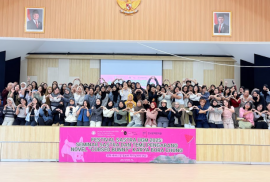Yogyakarta, Thursday, September 18, 2025 – The Faculty of Cultural Sciences, Universitas Gadjah Mada (FIB UGM), has once again marked an important academic milestone with the completion of a doctoral research in philology. Rahmat, a doctoral candidate in the Humanities Study Program, successfully defended his dissertation entitled “The Implementation of Serat Sèstradi in Pakualaman Folktales: A Philological Study.” The research was supervised by Promoter Prof. Dr. Sangidu, M.Hum., and Co-Promoter Dr. Sri Ratna Sakti Mulya, M.Hum.
This dissertation is rooted in the reality that Javanese literature in the Duchy of Pakualaman continues to serve as an intellectual legacy to this day. Literary works, particularly folktales, were produced for internal educational purposes and transmitted across generations. However, the diversity and depth of Pakualaman folktales have not been fully explored in previous scholarly studies.
In his research, Rahmat undertook a comprehensive approach that included inventory, description, transliteration, editing, and translation of folktale texts. He also analyzed the formal structures of the texts and revealed their purposes of creation. Through a critical edition method, the study presents thirteen manuscripts comprising a total of thirty-seven edited and translated folktales.
The findings show that Pakualaman folktales are generally composed in tembang macapat poetic form, containing core ideas and accompanied by liding dongèng or moral messages. These texts were not created merely for entertainment but also served as sources of knowledge and tools for character education. The embedded sèstradi values highlight the binary opposition of good and bad characters, functioning as moral guidance for the younger generation of Pakualaman to grow into noble individuals.
Rahmat further revealed that the creation of these folktales was influenced by the lèlaku (life experiences) of Pakualam as well as the historical context of their time. The messages conveyed through the texts emphasize the cultivation of resilience, perseverance in facing hardships, and the preparation of future generations to embrace societal changes. Thus, Pakualaman folktales function not only as literary heritage but also as vehicles of moral education and wisdom for life. This dissertation defence was also attended by the representatives of Pura Pakualaman GKBRAy Adipati Paku Alam X, GPH Indrokusumo, BRAy Indrokusumo, and GPH Wijoyo Harimurti.
This research contributes significantly to the preservation of Javanese cultural heritage and enriches the field of philology in Indonesia. Moreover, the dissertation aligns with the Sustainable Development Goals (SDGs), particularly SDG 4: Quality Education, by strengthening character education based on local wisdom. It also relates to SDG 11: Sustainable Cities and Communities, through the preservation of cultural values and traditions that constitute the historical identity of the Pakualaman Duchy.
[Public Relations Office, FIB UGM – Alma Syahwalani]








